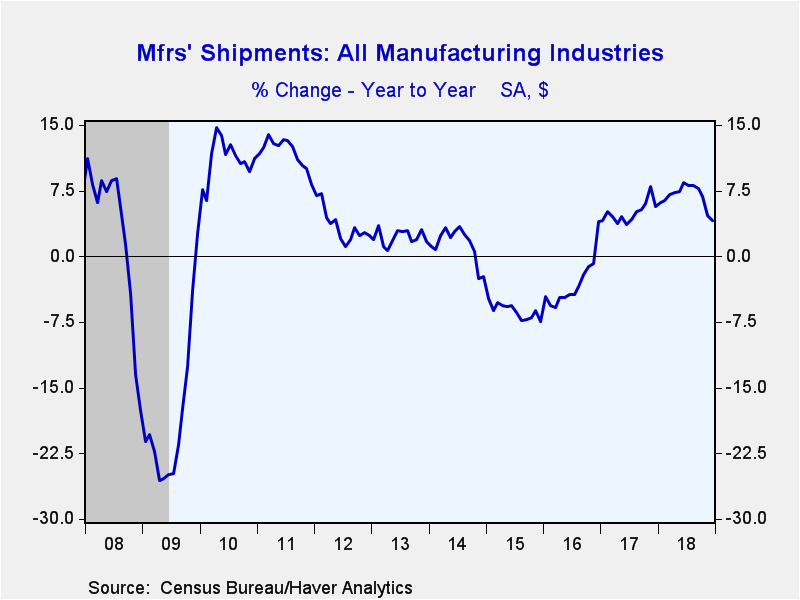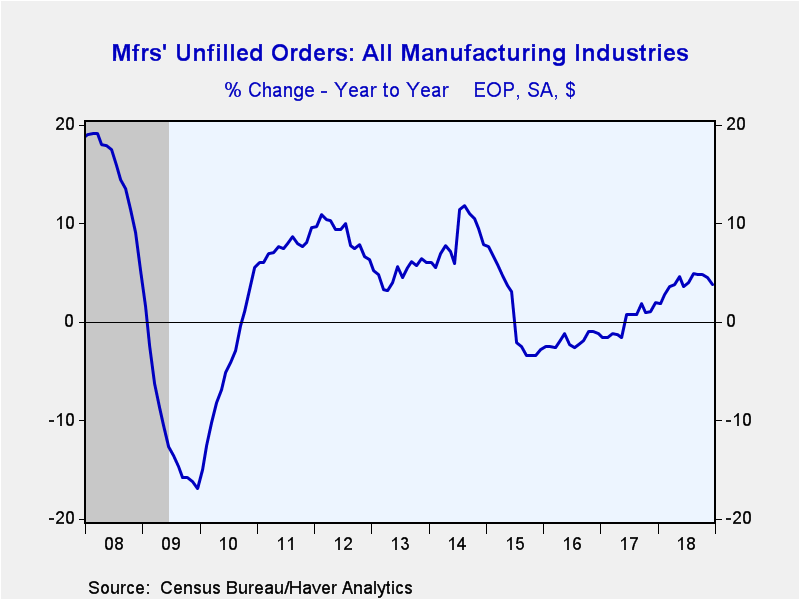 Global| Feb 27 2019
Global| Feb 27 2019Mixed Factory Orders and Shipments Data
Summary
Manufacturers' orders edged up 0.1% (2.4% year-on-year) in December following a slightly upwardly-revised 0.5% decline in November (this report was delayed as a result of the government shutdown). The Action Economics Forecast survey [...]
Manufacturers' orders edged up 0.1% (2.4% year-on-year) in December following a slightly upwardly-revised 0.5% decline in November (this report was delayed as a result of the government shutdown). The Action Economics Forecast survey looked for a 0.5% rise. Factory shipments shrank 0.2% (4.1% y/y), the third consecutive monthly decrease. Despite this weakness, shipments rose at a 0.8% annual rate in Q4 as strong August data created a healthy starting point for the quarter.
Orders in the volatile durable goods sector increased 1.2% (3.4% y/y) after a 0.9% gain in November. Orders for transportation equipment rose 3.2% (3.2% y/y) due to a 28.4% takeoff in volatile civilian aircraft bookings (-27.2% y/y). Total factory orders excluding transportation declined 0.6% (+2.2% y/y). Fabricated metal orders continued its strong quarter up 0.4% in December (6.0% y/y). Machinery orders decreased 1.0% (-0.4% y/y) after a 2.0% drop. Orders for computers & electronic products edged up 0.1% (7.8% y/y).
Shipments of durable goods grew 0.7% (6.9% y/y) in December. Shipments of transportation equipment increased 1.6% (12.2% y/y) driven by a 2.5% gain in passenger car and light trucks (15.4% y/y). Fabricated metal shipments increased 1.1% (7.2% y/y), while machinery declined 0.5% (+1.5% y/y). Computer & electronic product shipments rose 0.6% (7.0% y/y).
Nondurable goods shipments, which equal nondurable goods orders because nondurables are shipped in the same period they are ordered, declined 1.0% (+1.4% y/y). This decrease was driven a 5.5% drop in shipments from petroleum refineries (-2.7% y/y). Energy prices, in particular oil prices, have a significant role on the value of energy product activity in this report. West Texas intermediate oil prices plummeted 15.1% in the year ending December. Orders for the largest nondurable category, basic chemicals, rose 0.3% (4.1% y/y), food products, the second largest, decreased 0.3% (0.6% y/y).
Unfilled orders of durable goods, which as implied above equals unfilled factory orders, edged down 0.1% (+3.8% y/y). Transportation equipment backlogs decreased 0.2% (+3.5% y/y). Excluding the transportation sector, unfilled orders inched up 0.1% (4.6% y/y). Non-transportation unfilled orders have been on a steady rise since early 2017. Computer & electronic sector backlogs increased 0.3% (3.8% y/y), while machinery declined 0.3% (+2.3% y/y).
Inventories of manufactured products were unchanged in December (3.4% y/y) as durable goods inventories - which are roughly 60% of total inventories - rose 0.3% (4.6% y/y). Transportation ticked down 0.1% (+2.7% y/y). Inventories outside of transportation were unchanged (3.5% y/y). The machinery sector rose 0.3% (5.0% y/y) and fabricated metals increased 0.2% (7.8% y/y). Nondurable goods inventories declined 0.4% (+1.6% y/y) as petroleum refineries dropped 5.2% (-7.9% y/y). Basic chemical inventories decreased 0.3% (+4.3% y/y), while food product inventories grew 0.4% (-1.8% y/y).
All these factory sector figures and West Texas intermediate oil prices are available in Haver's USECON database.
| Factory Sector (% chg) - NAICS Classification | Dec | Nov | Oct | Dec Y/Y | 2018 | 2017 | 2016 |
|---|---|---|---|---|---|---|---|
| New Orders | 0.1 | -0.5 | -2.1 | 2.4 | 7.2 | 5.7 | -2.9 |
| Shipments | -0.2 | -0.5 | -0.1 | 4.1 | 6.8 | 5.0 | -3.2 |
| Unfilled Orders | -0.1 | -0.2 | -0.2 | 3.8 | 3.8 | 2.0 | -1.2 |
| Inventories | 0.0 | -0.1 | 0.2 | 3.4 | 3.4 | 4.5 | -0.7 |
Gerald D. Cohen
AuthorMore in Author Profile »Gerald Cohen provides strategic vision and leadership of the translational economic research and policy initiatives at the Kenan Institute of Private Enterprise.
He has worked in both the public and private sectors focusing on the intersection between financial markets and economic fundamentals. He was a Senior Economist at Haver Analytics from January 2019 to February 2021. During the Obama Administration Gerald was Deputy Assistant Secretary for Macroeconomic Analysis at the U.S. Department of Treasury where he helped formulate and evaluate the impact of policy proposals on the U.S. economy. Prior to Treasury, he co-managed a global macro fund at Ziff Brothers Investments.
Gerald holds a bachelor’s of science from the Massachusetts Institute of Technology and a Ph.D. in Economics from Harvard University and is a contributing author to 30-Second Money as well as a co-author of Political Cycles and the Macroeconomy.









